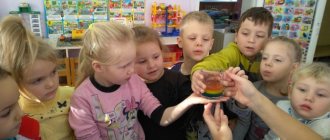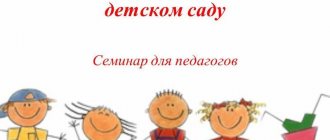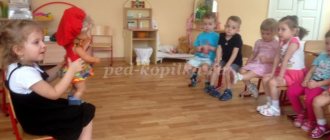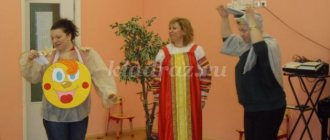The problem of communication abilities is the focus of attention of social psychologists due to its significance in all spheres of every person’s life.
Communication – the ability to communicate with peers and adults, understanding and self-awareness.
Communication is an important indicator of a child’s mental development. A person without communication cannot live among people. Communication is not just an action - it is precisely an interaction: it takes place between participants.
Modern society places high demands on the communicative activity of an individual. Society needs creative individuals who can think outside the box, express their thoughts competently, and find solutions in any life situations. In preschool age, children easily acquire new knowledge, retain and retain developed skills and abilities.
Communication activities involve:
1. Mutual enrichment of children with new learning experiences and forms of interaction.
2. Children’s mastery of different types of activities.
3. Establishing emotional interaction with children and adults.
Currently, the communicative development of a preschooler is alarming. It's no secret that TV and computers, computer games, have begun to replace communication and gaming activities for both children and adults. Communication and only live human communication enriches the lives of children.
Many children have impaired communicative speech function. Such children have unstable attention, poor memory, fatigue, insufficient development of cognitive activity, poor vocabulary, impaired grammatical structure of speech, and an immature emotional-volitional sphere. Preschoolers experience inhibitory processes and may exhibit timidity and stiffness. Children begin to be critical of their defects. Preschoolers cannot always formulate their thoughts correctly, answer questions correctly, cannot ask questions correctly, find it difficult to establish contact with both adults and peers, cannot conduct a restrained conversation with friends, enter into conflicts and find it difficult to resolve them peacefully and in a polite manner.
The ability to communicate is the most important condition for the successful social and intellectual development of a child. Considering that play in preschool age is the leading activity, it has become one of the most effective and accessible ways to develop the communicative abilities of preschoolers.
Theatrical play is a means of developing communication among preschool children. It is a good opportunity to reveal a child’s creative potential and nurture a creative personality. Children learn to notice interesting ideas in the world around them, embody them, create their own artistic image of a character, children develop creative imagination, associative thinking, and the ability to see unusual moments in the ordinary.
Collective theatrical activities are aimed at a holistic impact on the child’s personality, his emancipation, involvement in action, while activating all his capabilities; for independent creativity; development of all leading mental processes; promotes self-knowledge and self-expression of the individual with a fairly high degree of freedom; creates conditions for the socialization of the child, strengthens his adaptive abilities, corrects communication deviations; helps to realize the feelings of satisfaction, joy, significance that arise as a result of identifying hidden talents and potentials.
Theatrical activity simultaneously performs a cognitive, educational and developmental function.
The educational possibilities of theatrical activity are great, as it contributes to the development of the following communicative abilities:
1. Getting to know the world around you.
2. Formation of mental processes (attention, perception, memory, thinking, imagination).
3. Speech development (vocabulary, grammatical structure of speech, sound culture of speech, coherent speech skills, intonation and expressive speech are improved)
4. Development of the emotional-volitional sphere (the ability to recognize a person’s emotional state by facial expressions, gestures, intonation, the ability to put oneself in his place in various situations, to express one’s own attitude towards good and evil).
5. Formation of primary social behavior skills (kindness, friendship, honesty, courage).
6. The source of the development of feelings, deep experiences and discoveries of the child, introducing him to spiritual values (sympathy, empathy).
7. Improves motor skills, coordination, smoothness, switchability, and purposefulness of movements.
8. An idea of theater as an art is formed, and interest in theatrical and play activities appears.
9. Musical abilities are improved when creating artistic words.
All theatrical activities in my group are organized in such a way that they contribute to the development of mental activity, the development of mental processes, improve speech skills, increase emotional activity and correct communicative behavior.
Theatrical performances and theater games optimize the cognitive development of preschool children, introducing children to the rich world of images, human actions and relationships. The child learns to think through his actions, the actions of the characters, role-playing statements in advance, and selects expressive means - facial expressions, intonation, posture. Brightness, entertainment and allegory, inherent in the art of theater, make it possible to bring to the child’s consciousness sublime ideas about friendship, goodness, justice, and the beauty of human relationships. Theatrical play activities help to develop children's organization, independence, and communication skills. Preschoolers learn to reason consistently and prove their point of view.
Through role-playing statements, dramatic development of the plots of literary works, a preschool child learns the meaning and actively experiments with words, facial expressions, gestures, movements, and masters various ways of expressing thoughts, character, and image of the characters in the play.
By participating in theatrical play activities, children learn about the world and become participants in events from the life of the natural world and people. All theatrical games are based on the material of fairy tales and while playing, children learn to tell a coherent story, feel, convey intonation, actively use movements, facial expressions and gestures
Principles for the development of communicative abilities that are formed in theatrical activities:
1. The principle of intergativity (interrelation with other types of activities).
2. Variety of topics and working methods.
3. Maximum activity of children.
4. Cooperation of children with each other and with adults (relationship between child and adult).
5. Teacher competence.
6. The principle of an individual approach to children (differentiated approach).
7. The principle of game presentation of material.
Types of motivations in theatrical play:
- Social (creating a situation of success, using praise, encouragement, the child’s right to make mistakes).
- Content-based (formation of experience in collective and creative activities, organization of individual work with children).
- Pragmatic (increasing children’s attention to this type of activity and developing cognitive interest).
It is necessary to create a subject-development environment in the group room, which provides the opportunity to simultaneously engage in different types of activities. Our group has decorated theater zones that differ from each other: “mini-museum”, “theater stage”, “in the land of theatre”, “mummering corner”. The creation of such zones encourages children to engage in independent creative activities and play theater.
Theater centers are represented by a variety of equipment and the following materials: books, theatrical masks and individual costume elements, sets of puppets, screens, various types of theaters (bi-ba-bo, shadow, tabletop, spoon theater, finger theater, puppet theater with a “living hand” , parsley theater, variety theater, dramatization theater, theater on platters, theater on an umbrella, theater in a balloon, theater on the palms, theater of pictures (flannelgraph), attributes and decorations (model of a tree, house, flowers, and so on).
Principles of organizing the theatrical environment:
1. The principle of distance (communication between an adult and a child “eye to eye.”
2. The principle of activity, independence, creativity.
3. The principle of stability-dynamism.
4. The principle of integration and flexible zoning (children engage in different types of activities simultaneously without interfering with each other).
5. The principle of emotionality (individual comfort and emotional well-being of each child).
6. The principle of aesthetic organization (a combination of the familiar and the new).
7. The principle of gender and age differences (standards of masculinity and femininity).
Work on developing children's communicative abilities through theatrical activities goes through the main types of activities and in their interrelation; it can be organized in the morning and evening hours, at any free time during the day.
All work must be systematized in such a way that the teacher stimulates the motor, intonation, and creative activity of all children every time.
The development of children’s communicative abilities through theatrical activities, their frequent performances contribute to the realization of children’s creative powers and spiritual needs, emancipation and increased self-esteem, and overall development; manifestation of curiosity, desire to assimilate new information, development of associative thinking, perseverance, manifestation of general intelligence, emotions. Children develop the ability to combine images, intuition, the ability to improvise, develop melodic and intonation expressiveness, and fluency of speech. The most important thing is that participation in theatrical games brings joy to children, arouses active interest, and captivates them.
Literature
1. Artyomova L.V. Theatrical games for preschoolers. M.: Education, 2008.
2. Bodrachenko I.A. Magazine “Modern Preschool Education” No. 3, 2010.
3. Dronova T.N. We play in the theater. Theatrical activities for children aged 4-6 years. M.: Education, 2005.
4. Kasatkina E.I. Game in the life of a preschooler. M.: Bustard, 2010.
5. Kislinskaya T. A. Fairy tale games for palms from the thirtieth kingdom - the solar state. M.: Genesis, 2009.
The influence of theatrical play on the development of a child’s general abilities
Play in the preschool period is the main activity of children and has a great influence on their mental development (L.S. Vygotsky, A.V. Zaporozhets, A.L. Leontyev, A.A. Lyublinskaya, D.B. Elkonin, etc. ) The term “game” summarizes various manifestations of children’s activities, which differ, first of all, in the nature of the actions and their focus - these are didactic, active, role-playing games, theatrical, musical and others. Thus, theatrical play, as one of the types of play activities, has a significant impact on the course of development of the child’s personality.
The value and peculiarity of theatrical art and its works lies in instant empathy, cognitive, emotional, communicative, vivid impact of the artistic image on the individual (A.V. Zaporozhets, A.A. Leontiev, A.N. Leontiev, Ya.Z. Neverovich) . Therefore, the role of theater in the aesthetic development of preschool children is invaluable, as evidenced by the research of A.M. Vinogradova, S.I. Merzlyakova. In the process of perceiving works of art, children develop a special type of cognition in the form of emotional images (L.I. Bozhovich, A.V. Zaporozhets). On the one hand, they reflect the external image of the surrounding world, on the other hand, the internal component in the form of sensations and ideas gives the emotional image a stimulating, activating character of reflection of the surrounding reality.
At a certain stage of mental development as a result of upbringing in preschool age, as noted by A.V. Zaporozhets, that side of aesthetic perception is revealed, which gives impetus to the development of its cognitive reality. This happens due to the fact that a work of art (visual, musical, literary) not only introduces the child to new phenomena and expands the range of his perception, but also allows him to understand his artistic image. In imaginary relationships, fairy tales, on the basis of which children’s habits and patterns of activity, aspirations and ideals, animal life and the natural world are usually formed.
The aesthetic perception of children, including the perception of theater, is not reduced to passive observation of certain aspects of reality. A preschool child has access to the internal activity of assistance, empathy, and the ability to mentally act in imaginary circumstances (L.S. Vygotsky, A.V. Zaporozhets, etc.). Older preschoolers are also able to understand the inner world of heroes and their contradictory nature. This makes it possible to use drama in the moral education of children, when various norms become significant for the child, correlating not only with a positive, but also with a negative, unattractive character (L.G. Lysyuk, S.G. Yakobson). Thanks to it, social feelings are formed, an emotional attitude to events and actions that are significant not only for the child personally, but also for those around him.
Drama is an extremely emotional activity, which makes it attractive to children. This brings great joy and surprise to the child. It contains the origins of creativity; children accept the guidance of an adult without realizing it. Theatrical activity most fully embraces the child’s personality and corresponds to the peculiarities of the development of his mental processes: Holism and simultaneity of perception, ease of imagination and faith in transformations, emotional sensitivity, not only figurative, but also logical thinking, motor activity, etc. (L.S. Vygotsky, D.B. Elkonin, etc.). This indicates the broad potential for the development of a dramatic play.
"Dramateshka" is the largest archive of children's plays in RuNet
Based on the tasks for the development of theatrical activities with preschoolers, its content of work in kindergarten is determined (Appendix 3). However, the forms of organization can be different. For example, L.V. Kutsakova and S.I. Merzlyakova distinguish: classes (frontal, subgroup and individual), holidays, entertainment, performances, theatrical actions (Scheme 6). The main form is occupation. Forms of organizing theatrical activities (Diagram 6)
L.V. Kutsakova and S.I. Merzlyakova identified the following types of theater classes (Diagram 7)
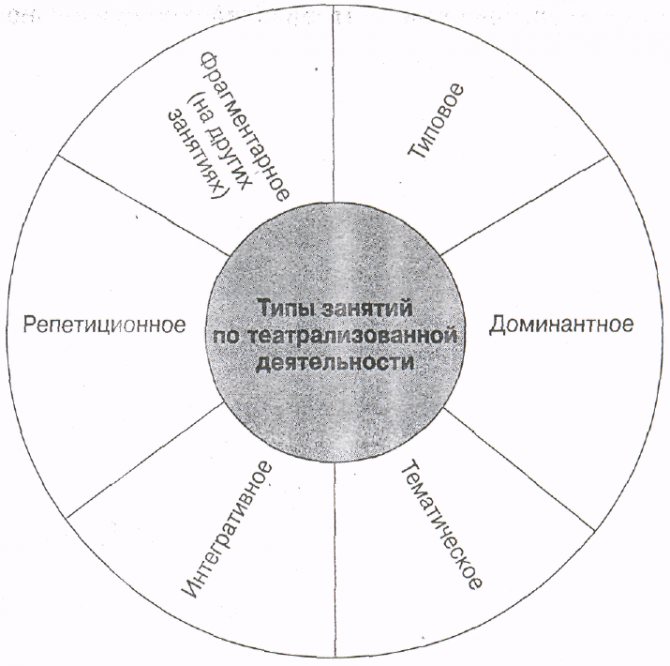
Typical ones, which include the following types of activities: theatrical gaming, rhythmoplasty, artistic speech, theatrical alphabet (elementary knowledge of theatrical art). Dominant - one of the specified types of activity dominates. Thematic, in which all the named types of activities are united by one topic, for example: “What is good and what is bad?”, “About dogs and cats,” etc. Complex - a synthesis of arts is used, an idea is given about the specifics of the arts (theater , choreography, poetry, music, painting), about modern technical means (audio, video materials). All types of artistic activity are united, alternate, there are similarities and differences in works, means of expression of each type of art, conveying the image in their own way. Integrated, where the core activity is not only artistic, but also any other activity. Rehearsal rooms, where a “run-through” of the performance being prepared for production or its individual fragments is carried out. When organizing classes, it is necessary to remember that knowledge and skills acquired without desire and interest do not stimulate the cognitive activity of preschoolers. Questions: 1. List the main forms of organizing theatrical activities with preschoolers. 2. Name the types of theater classes in preschool educational institutions. Assignment for independent work: Prepare a summary of one type of theater lesson with children of senior preschool age. Literature 1. Antipina E.A. Theatrical activities in kindergarten.-M., 2003. 2. Botnar V.D., Suslova E.K. Dramatization games are the basis for acquaintance with the culture of other peoples // Preschool education. – 1994. – No. 3. 3. Konovich A.A. Theatrical celebration and rituals. – M., 1990. 4. Kutsakova L.V., Merzlyakova S.I. Raising a preschool child: developed, educated, independent, proactive, unique, cultural, active and creative. - M.: Vlados, 2004. 5. Makhaneva M. Theatrical activities of preschoolers // Preschool education. – 1999. – No. 11. 6. Sorokina N.F. Playing puppet theater: Program “Theatre-creativity-children.”-M.: ARKTI, 2004. 7. Churilova E.G. Methods and organization of theatrical activities for preschoolers and primary schoolchildren. - M.: Vlados, 2001.
MAGAZINE Preschooler.RF
Features of organizing theatrical activities with preschool childrenCurrently, a great deal of theoretical and practical experience has been accumulated in organizing theatrical activities in kindergarten. The works of domestic teachers, scientists, methodologists are devoted to this: N. Karpinsky, A. Nikolaicheva, L. Furmina, L. Voroshnina, R. Sigutkina, I. Reutskaya, L. Bochkareva, I. Medvedeva, T. Shishova and others.
Theater activities should provide children with the opportunity not only to study and understand the world around them through comprehension of fairy tales, but to live in harmony with it, receive satisfaction from classes, a variety of activities, and successful completion of tasks. From this point of view, the organization and space of the theater room is of great importance.
The environment is one of the main means of developing a child’s personality, the source of his individual knowledge and social experience. Moreover, the subject-spatial environment should not only ensure joint theatrical activities of children, but also be the basis for the independent creativity of each child, a unique form of his self-education. Therefore, when designing a subject-spatial environment that provides theatrical activities for children, the following should be taken into account:
- individual socio-psychological characteristics of the child;
- features of his emotional and personal development;
- interests, inclinations, preferences and needs;
- curiosity, research interest and creativity;
- age and gender role characteristics.
The socio-psychological characteristics of preschool children suggest the child’s desire to participate in joint activities with peers and adults, as well as the need for privacy that arises from time to time. At the same time, to ensure an optimal balance of joint and independent theatrical activities of children, each age group should be equipped with a theater area or a fairy tale corner, as well as a “quiet corner” where the child can be alone and rehearse a role in front of a mirror or look at the illustrations again for a performance, etc.
In order to realize the individual interests, inclinations and needs of preschoolers, the subject-spatial environment should ensure the right and freedom of choice of each child for any activity or for the theatrical performance of a favorite work. Therefore, in the area of theatrical activity there should be different types of puppet theater (finger, bi-ba-bo, puppet), children's drawings, etc. In addition, it is necessary to periodically update material focused on the interests of different children.
The development of curiosity and research interest is based on the creation of a range of opportunities for modeling, searching and experimenting with various materials when preparing attributes, scenery and costumes for performances. To do this, in the area of theatrical activity it is necessary to have a variety of natural and waste materials, fabrics, and costumes for dressing up.
Taking into account the gender role characteristics of children, equipment and materials are placed in areas for theatrical activities that meet the interests of both boys and girls.
The content of theatrical classes includes:
- watching puppet shows and talking about them;
- dramatization games;
- acting out various fairy tales and dramatizations;
- exercises to develop expressiveness of performance (verbal and non-verbal);
- exercises for the social and emotional development of children.
Of course, the teacher plays a huge role in theatrical activities. The teacher himself needs to be able to read expressively, tell, look and see, listen and hear, be ready for any transformation, i.e. master the basics of acting and directing skills. One of the main conditions is the adult’s emotional attitude to everything that happens, sincerity and genuineness of feelings. The intonation of the teacher’s voice is a role model. Therefore, before offering children any task, you should practice yourself several times.
Methodological recommendations for organizing theater classes.
During classes you must:
- listen carefully to children’s answers and suggestions;
- if they do not answer, do not demand explanations, proceed to actions with the character;
- when introducing children to the heroes of works, set aside time so that they can act or talk with them;
- ask who did something similar and why, and not who did it better;
- Finally, in various ways to bring joy to children.
Basic requirements for organizing theatrical games in kindergarten:
- Content and variety of topics.
- The constant, daily inclusion of theatrical games in all forms of the pedagogical process, which makes them as necessary for children as role-playing games.
- Maximum activity of children at the stages of preparation and conduct of games.
- Cooperation of children with each other and with adults at all stages of organizing a theatrical game.
Theatrical activities in kindergarten can be organized in the morning and evening hours at unregulated times; is organically included in various other classes (musical, artistic, etc.), and is also specially planned in the weekly schedule of classes in the native language and familiarization with the outside world. It is desirable that all organized forms of theatrical activities be carried out in small subgroups, which will ensure an individual approach to each child. Moreover, each time subgroups should be formed differently, depending on the content of the classes.
In accordance with the inclinations and interests of children, the work of various studios can be organized in the evening ( "Puppet Theater for Kids" , "Theater Salon" , "Visiting a Fairy Tale" , etc.)
Duration of each lesson: 15 – 20 in the junior group, 20 – 25 minutes in the middle group and 25 – 30 minutes in the senior group. Individual work and general rehearsals are held once a week for no more than 40 minutes. It is advisable to conduct classes in a spacious, regularly ventilated room using soft, three-dimensional modules of various designs with the presence of a musical instrument and audio equipment. Lightweight clothing, preferably sports, soft shoes or slippers are required.
The first theatrical games are conducted by the teacher himself, involving the children in them. Further, the lessons use small exercises and games in which the teacher becomes a partner in the game and invites them to take the initiative in organizing it, and only in older groups can the teacher sometimes be a participant in the game and encourage children to be independent in choosing a plot and playing it out.
Particular attention in organizing theatrical activities is paid to the interaction of the preschool educational institution with the family. This work implements the following tasks:
- Maintain the child's interest in theatrical activities. Whenever possible, try to attend children's performances.
- Discuss with the child before the performance the features of the role that he will play, and after the performance - the result obtained. Celebrate achievements and identify ways for further improvement.
- Offer to perform the role you like at home, help act out your favorite fairy tales, poems, etc.
- Tell friends in the presence of the child about his achievements.
- Tell your child about your own impressions received as a result of watching plays, movies, etc.
- Gradually develop in the child an understanding of theatrical art, a specific “theatrical perception” based on communication between a “living artist” and a “living spectator” .
- Whenever possible, organize visits to theaters or viewings of video recordings of theatrical performances.
Thus, such an organization of theatrical activities contributes to the self-realization of each child and the mutual enrichment of everyone, since adults and children act here as equal partners of interaction. It is in the general performance that the child naturally and easily assimilates the rich experience of adults, adopting patterns of behavior. In addition, in such joint activities, educators get to know children better, their character traits, dreams and desires. A microclimate is created, which is based on respect for the personality of the little person, care for him, and trusting relationships between adults and children.
| Next > |
Forms of organizing theatrical play activities in kindergarten
L.V. Artemova uses synonyms for the concepts of “theatrical play,” “theatrical play activity and creativity,” and “dramatization play.” The author believes that theatrical play retains all the structural components of the plot-role-playing game identified by D.B. Elkonin:
role (defining component);
game actions;
playful use of objects;
real relationships[3].
In theatrical games, the play action and the play object, a costume or a doll, are of greater importance, as they facilitate the child’s acceptance of the role that determines the choice of play actions. The characteristic features of theatrical play are the literary or folklore basis of the content and the presence of spectators (L.V. Artemova, L.V. Voroshina, L.S. Furmina, etc.). They can be divided into two main groups : dramatizations and directorial ones (each of them, in turn, is divided into several types).
Types of theaters:
1) Tabletop toy theater. Toys and crafts are used that stand steadily on the table and do not interfere with movement.
2) Tabletop picture theater. Characters and settings – pictures. Their actions are limited. The state of the character, his mood is conveyed by the intonation of the player. Characters appear as the action progresses, which creates an element of surprise and arouses the interest of children.
3) Stand-book. The dynamics and sequence of events are depicted using alternating illustrations. Turning over the sheets of the book stand, the presenter demonstrates various scenes depicting events and meetings.
4) Flannelograph. Pictures or characters are displayed on the screen. They are held in place by flannel, which covers the screen and the back of the picture. Instead of flannel, you can glue pieces of velvet or sandpaper to the pictures. Drawings are selected together with children from old books, magazines or created independently.
5) Shadow theater. It requires a screen made of translucent paper, black flat characters and a bright light source behind them, thanks to which the characters cast shadows on the screen. The image can also be obtained using your fingers. The display is accompanied by appropriate sound [3].
In a theatrical play, the image of the hero, his main features, actions, and experiences are determined by the content of the work. The child’s creativity is manifested in a truthful portrayal of the character [2]. To do this, you need to understand what the character is like, why he acts this way, imagine his state, feelings, and be able to analyze and evaluate his actions. This largely depends on the child’s experience: the more diverse his impressions of the life around him, the richer his imagination, feelings, and ability to think. Therefore, it is very important, T. Nemenova believes, to introduce a child to music and theater from a very early age. To captivate children with art and teach them to understand beauty is the main mission of the educator and music director [6]. It is art (theater) that awakens in a child the ability to think about the world, about himself, about responsibility for his actions. The very nature of theatrical play (showing a play) lies in its connections with a role-playing game (playing theatre), which makes it possible to unite children with a common idea, experiences, and unite them on the basis of interesting activities that allow everyone to show activity, creativity and individuality.
